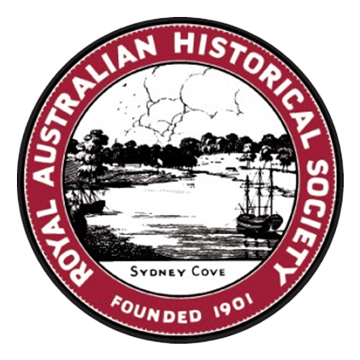RAHS Subscriptions: Journals – Vol 111 Pt 1 June 2025 Editorial & Abstracts
Editorial:
Challenging Narratives: New perspectives on authority, identity, and colonial Australia
Samuel White
The spearing of Governor Phillip at Manly
Keith Amos
The spearing of Governor Phillip on a Sydney Harbour beach in 1790 is a significant incident in Australian history. Was it a spur-of-the-moment act, a premeditated ‘payback’, or is there another explanation? Though the incident is factually well known, why it happened has ample scope for further consideration. This paper questions the ritualistic explanations of Governor Phillip’s spearing characteristic of most historical interpretations of the incident since 2001. It concludes that Phillip’s assailant acted defensively of his own volition in the heat of the moment.
John [Milner] Clark 1824–76: The fortunes of a fugitive
Mark St Leon
This article traces the life and career of an identity of early Wagga Wagga, John Clark (1824–76). Held in high esteem throughout the town and district, Clark was a publican, alderman and entrepreneur. Yet, unbeknownst to everyone, including his own family, he was also a fugitive from justice.
Frederick G. G. Rose, the Australian Institute of Aboriginal Studies and academic freedom
Geoffrey Gray
The Australian Government established the Australian Institute of Aboriginal Studies (AIAS) in 1961 and made it permanent through an Act of Parliament in 1964. It was to record and collect the remaining cultural knowledge of Aboriginal and Torres Strait Islander people living a traditional lifestyle in all its aspects: ‘before it was too late’. AIAS had a veneer of academic independence, and so long as it dealt with bona fide researchers and their research projects, their political orientation was not considered. Nevertheless, when confronted with funding a research application by Frederick G. G. Rose, it was the applicant rather than the research project that was problematic. This paper examines Rose’s dealings with the AIAS, the difficulties it faced in supporting academic and political freedom, and pressure from government to deny Rose funding.
Brigadier José Bustamante’s 1796 plan to attack NSW: New documents from the first foreign delegation at Sydney − the Malaspina and Bustamante expedition
Chris G. Maxworthy
In 1788 the King of Spain, Carlos III, authorised an enlightenment voyage by two Captains of the Spanish Royal Navy, Alejandro Malaspina and José de Bustamante y Guerra. This political-scientific expedition took four years. This paper explores the Malaspina-Bustamante expedition, the first official foreign delegation to visit Port Jackson following the arrival of the First Fleet in 1788.
With anticipation of war against Britain, in mid-1796 Bustamante wrote a plan for the defence of Spanish America and Spain’s interests in the Pacific. One part of his plan was the destruction of the Sydney colony with gunboats from Peru, Chile and Montevideo. The inhabitants of Sydney and Norfolk Island would become prisoners of war and be transported to South America. It was hoped that some of these colonial prisoners might populate the Spanish Americas. Bustamante was tasked by senior Spanish ministers to develop his plan.
In parallel with Bustamante’s work was the rapidly expanding British southern whale fishery that had commenced its operations in the Pacific Ocean from 1789. While first a peaceful activity, once war between Britain and Spain commenced then these whalers were also privateers – operating against Spanish colonial ports and shipping.
For Spain the elimination of the colony at Sydney was important for the preservation of Spanish control in the Pacific and the suppression of whaling privateers. This essay describes the Bustamante plan and its aftermath as British interests in the Pacific Ocean transformed what had been a silent backwater before 1788. Additional information on Spanish language sources for a view of Australian history is also explored. This paper should add to the understanding of one European power’s strategic response to the new British colony in the southwest Pacific.
Book Reviews
Lucy Frost, Convict orphans: The heartbreaking stories of the colony’s forgotten children, and those who succeeded against all odds, Allen & Unwin, Sydney, NSW, 2023, 296 pages; ISBN 9781761067686.
Lucas Jordan, The Chipilly Six: Unsung heroes of the Great War, NewSouth Publishing, Sydney, NSW, 2023, xi + 307 pages; ISBN 9781742238098.
Hannah Forsyth, Virtue Capitalists: The rise and fall of the professional class in the Anglophone world, 1870–2008, Cambridge University Press, New York, 2023, xii + 299 pages; ISBN 9781009206488.
David Dufty, Charles Todd’s Magnificent Obsession: The epic race to connect Australia to the world, Allen & Unwin, Sydney, 2024, vii + 354 pages; ISBN 9781761471353.
John Kennedy McLaughlin, The Immigration of Irish Lawyers to Australia in the Nineteenth Century: Causes and Consequences, Alexandria, NSW, The Federation Press, 2024, xxv + 292 pages; ISBN: 9781760024536.
Anne Coote, Knowledge for a Nation: Origins of The Royal Society of New South Wales, Royal Society of New South Wales, Sydney, NSW, 2024, xiii + 304 pages; ISBN 9780645859409.
Robert Cox, Breakout! The Tasmanians who terrorised Victoria, Wakefield Press, Mile End, SA, 2024, xv + 278 pages; ISBN 9781923042728.
Bob Crawshaw, Battle of the Banks: How ad men, barristers and bankers ended Ben Chifley’s boldest plan, Australian Scholarly Publishing, North Melbourne, Vic, 2023, xi + 223 pages; ISBN 9781923267275.
